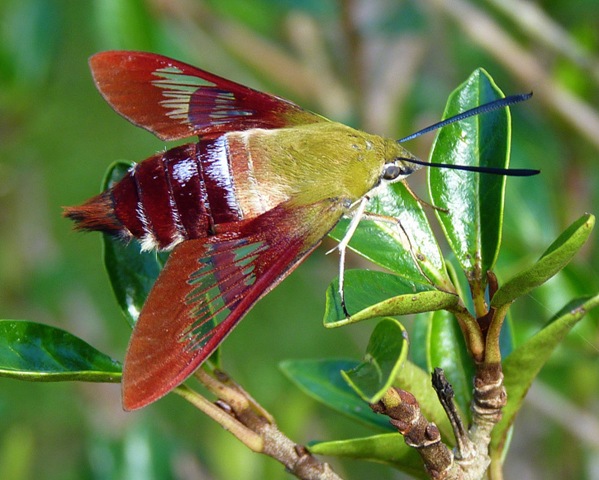Classification
Hemaris thysbe is commonly known as the "Hummingbird Clearwing Moth" for the observable behavior similar to that of a hummingbird that will hover above a plant while it collects the nectar food. Hemaris possesses a remarkable trait of having clear spots in the middle parts of its wings, which also gives explanation to the rise of its more commonly known name. Thysbe comes from the Greek story of Pyramis and Thysbe, giving the moth a sense of love.
Hemaris thysbe belongs the the family Sphingidae which are known as Sphinx or Hawk moths. Sphinx moths are among the largest and most easily recognizable Lepidoptera. The proboscis is well developed and usually is longer that the full length of the organisms body when it is fully extended. Under normal situations this will occur when the moth is feeding from a flower as it is hovering.
Most sphinx moths are night flying (crepuscular) moths that hover
over pale colored, deep flowers, however moths that do fly during
the day are among the most familiar (Scoble 1992). Day flying moths have
the habit of hovering over flowers to feed and both primaries and secondaries
are transparent about the middle of the wing
(Marshall 2006).

They possess round pointed bodies protruding well beyond the hind wings and frequently are found with tufts of hair at the end or along the lateral sides (Swan 1972). The body is relatively stout, the abdomen conic, cylindrical or flattened on the ventral surface. Eyes are often large, prominent and generally naked. The antennae are well developed, which are generally stouter in male sex, and the tip of the wing is usually pointed. The thorax is smooth and strongly projects before the insertion of the wings. In males the anal end is adorned with a fan shaped anal tuft (Holland 1903).
Lepidoptera is the order of the butterflies and moths. Lipido, meaning scale, and ptera, meaning wings, give this order its name. If you have ever touched the wings of a butterfly or moth you know that a color transfer takes place, leaving scale-like flakes of color on your skin. Butterflies and moths both have caterpillar larvae, who most of the time go through metamorphosis to become winged adults.
The class insecta is used in the classification of insects. This class contains a large variety of different shaped and sized insects, however all of the insects do share some of the same body plans. Every insect's body is composed of three parts; thorax, abdomen, and head. In addition, they all have antennae, wings, and six legs.
The phylum Arthropoda contains animals that are considered arthropods. Arthropods have segmented bodies which effects the overall structure. These animals have a complex muscle structure made of smooth and striated components. Arthropods are also eucoelomates.
Hermaris Thysbe is part of the large kingdom known as Animalia. Animals are multicellular organisms which get their food from eating other organisms. Also, all animals require oxygen to live, even fish (H20).
Lastly, the hummingbird clearwing moth comes from the domain Eukarya. This domain consists of all organisms which contain genetic material within a nuclear membrane. The name means "true kernal", which makes sense because the membrane holds the DNA.